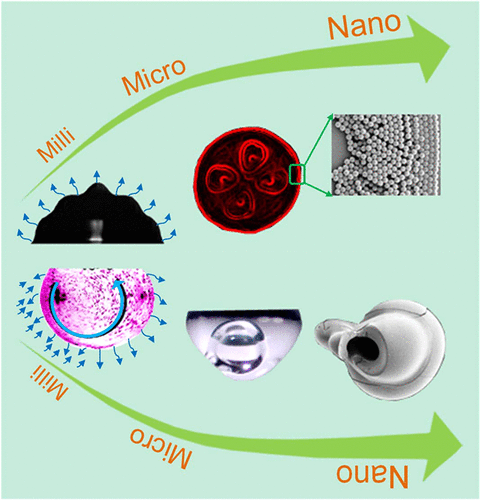Our official English website, www.x-mol.net, welcomes your feedback! (Note: you will need to create a separate account there.)
Engineering Interfacial Processes at Mini-Micro-Nano Scales Using Sessile Droplet Architecture
Langmuir ( IF 3.9 ) Pub Date : 2018-02-22 00:00:00 , DOI: 10.1021/acs.langmuir.7b04295 Lalit Bansal , Apratim Sanyal , Prasenjit Kabi , Binita Pathak , Saptarshi Basu
Langmuir ( IF 3.9 ) Pub Date : 2018-02-22 00:00:00 , DOI: 10.1021/acs.langmuir.7b04295 Lalit Bansal , Apratim Sanyal , Prasenjit Kabi , Binita Pathak , Saptarshi Basu

|
Evaporating sessile functional droplets act as the fundamental building block that controls the cumulative outcome of many industrial and biological applications such as surface patterning, 3D printing, photonic crystals, and DNA sequencing, to name a few. Additionally, a drying single sessile droplet forms a high-throughput processing technique using low material volume which is especially suitable for medical diagnosis. A sessile droplet also provides an elementary platform to study and analyze fundamental interfacial processes at various length scales ranging from macroscopically observable wetting and evaporation to microfluidic transport to interparticle forces operating at a nanometric length scale. As an example, to ascertain the quality of 3D printing we must understand the fundamental interfacial processes at the droplet scale. In this article, we review the coupled physics of evaporation flow–contact-line-driven particle transport in sessile colloidal droplets and provide methodologies to control the same. Through natural alterations in droplet vaporization, one can change the evaporative pattern and contact line dynamics leading to internal flow which will modulate the final particle assembly in a nontrivial fashion. We further show that control over particle transport can also be exerted by external stimuli which can be thermal, mechanical oscillations, vapor confinement (walled or a fellow droplet), or chemical (surfactant-induced) in nature. For example, significant augmentation of an otherwise evaporation-driven particle transport in sessile droplets can be brought about simply through controlled interfacial oscillations. The ability to control the final morphologies by manipulating the governing interfacial mechanisms in the precursor stages of droplet drying makes it perfectly suitable for fabrication-, mixing-, and diagnostic-based applications.
中文翻译:

使用微滴结构在微型-微纳米尺度上工程界面过程
固着功能性液滴的蒸发是控制许多工业和生物应用(例如表面图案,3D打印,光子晶体和DNA测序等)的累积结果的基本构件。另外,干燥的单固着小滴形成了使用低材料量的高通量处理技术,该技术特别适用于医学诊断。固着小滴还提供了一个基本的平台,用于研究和分析各种长度尺度上的基本界面过程,这些范围从宏观上可观察到的润湿和蒸发到微流体传输,再到以纳米长度尺度运行的粒子间作用力。例如,要确定3D打印的质量,我们必须了解液滴尺度的基本界面过程。在本文中,我们回顾了固着胶体液滴中蒸发流-接触线驱动的颗粒传输的耦合物理原理,并提供了控制它们的方法。通过液滴蒸发的自然变化,人们可以改变蒸发模式和接触线动力学,从而导致内部流动,从而以非平凡的方式调节最终的颗粒组装。我们进一步表明,对颗粒运输的控制也可以通过自然界中的热,机械振荡,蒸气限制(壁或液滴)或化学(表面活性剂诱导)的外部刺激来施加。例如,可以简单地通过受控的界面振荡来实现固着液滴中原本由蒸发驱动的粒子传输的显着增强。
更新日期:2018-02-22
中文翻译:

使用微滴结构在微型-微纳米尺度上工程界面过程
固着功能性液滴的蒸发是控制许多工业和生物应用(例如表面图案,3D打印,光子晶体和DNA测序等)的累积结果的基本构件。另外,干燥的单固着小滴形成了使用低材料量的高通量处理技术,该技术特别适用于医学诊断。固着小滴还提供了一个基本的平台,用于研究和分析各种长度尺度上的基本界面过程,这些范围从宏观上可观察到的润湿和蒸发到微流体传输,再到以纳米长度尺度运行的粒子间作用力。例如,要确定3D打印的质量,我们必须了解液滴尺度的基本界面过程。在本文中,我们回顾了固着胶体液滴中蒸发流-接触线驱动的颗粒传输的耦合物理原理,并提供了控制它们的方法。通过液滴蒸发的自然变化,人们可以改变蒸发模式和接触线动力学,从而导致内部流动,从而以非平凡的方式调节最终的颗粒组装。我们进一步表明,对颗粒运输的控制也可以通过自然界中的热,机械振荡,蒸气限制(壁或液滴)或化学(表面活性剂诱导)的外部刺激来施加。例如,可以简单地通过受控的界面振荡来实现固着液滴中原本由蒸发驱动的粒子传输的显着增强。


























 京公网安备 11010802027423号
京公网安备 11010802027423号